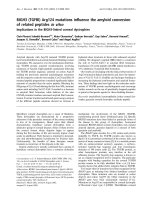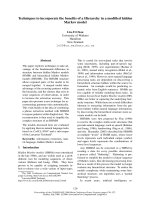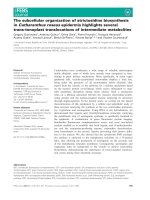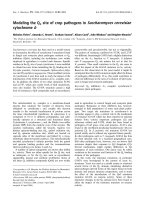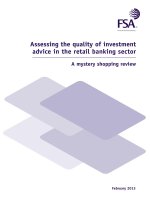Improving the financial appraisal of investment projects in BIDV giaiphong
Bạn đang xem bản rút gọn của tài liệu. Xem và tải ngay bản đầy đủ của tài liệu tại đây (540.6 KB, 69 trang )
NATIONAL ECONOMICS UNIVERSITY
CENTRE FOR ADVANCED EDUCATIONAL PROGRAMS
BACHELOR’ S THESIS
Major: Finance
TOPIC: Improving the financial appraisal of
investment projects in BIDV Giai Phong
DINH THI KIEU TRANG
HANOI, 2016
NATIONAL ECONOMICS UNIVERSITY
CENTER FOR ADVANCED EDUCATIONAL PROGRAMS
------ ------
.........................................................................................................................................
BACHELOR’ S THESIS
1
TOPIC: Improving the financial appraisal of
investment projects in BIDV Giai Phong
Student
Major
Class
Student’ s ID
Supervisor
:
:
:
:
:
ĐINH THỊ KIỀU TRANG
Finance
Advanced Finance 54B
11124079
Prof. TẠ VĂN LỢI, PhD.
Hanoi, 2016
ACKNOWLEDGEMENT
First of all, I would hereby like to write for the people who strongly support me
to complete my bachelor’s thesis.
I wish to express my profound sense of gratitude to Mr. Ta Van Loi, my
supervisor, for his enthusiastic guidance, useful advices and recommendations and
great encouragement in carrying out this project work.
I would also like to thank Mrs. Vu Thi Thu Ha, my internship guide, for giving
me valuable experiences about banking and especially, investment appraisal, strong
support me gather data as well as information that are necessary for my report.
My grateful thank are also due to the staffs at BIDV Giai Phong, and at Risk
Management Department in particular, for their help and support during the time of my
internship.
2
Table of Contents
STATUTORY DECLARATION
I herewith formally declare that I myself have written the submitted Barchelor’s
Thesis independently. I did not use any outside support except for the quoted literature
and other sources mentioned at the end of this paper.
Hanoi, 02/06/2016
Signature
ABBREVIATION
3
BIDV:
IP:
IRR:
NPV:
DSCR:
Bank for Investment and Development of Vietnam
Investment project
Internal rate of return
Net present value
Debt service coverage ratio
LIST OF TABLES
Table 1: Deposit and borrowing of BIDV Giai Phong 2012-2014)
Table 2: The rate of return on assets (ROA) of BIDV Giai Phong 2012-Jun2015
Table 3: The rate of return on equity (ROE) of BIDV Giai Phong 2012-Jun2015
Table 4: Project loan in BIDV Giai Phong 2013-2015 (billion VND)
Table 5: Revenue (Dai Huu Company)
Table 6: Annual repayment schedule (Dai Huu Comepany)
4
Table 7: Business Performance (Dai Huu Company)
Table 8: Cash flow in the view of bank (Dai Huu Company)
Table 9: Cash flow in the view of investor (Dai Huu Company)
Table 10: The effectiveness of Nam Ha project
LIST OF FIGURES
Figure 1: BIDV organization structure
Figure 2: Growth rate of mobilized capital of BIDV Giai Phong from 2012 to 6/2015
Figure 3: Mobilization interest rate on average of BIDV Giai Phong (2012-2014)
Figure 4: Mobilization costs weighted average of BIDV Giai Phong (2012-2014)
Figure 5: Mobilization from deposits of BIDV Giai Phong (2012-2015)
Figure 6: Operating expenses of BIDV Giai Phong 2012-Jun2015
Figure 7: Profit margin of BIDV Giai Phong 2012-Jun2015
5
Executive Summary
As we all know, banking system had played an integral role in promoting the
stability and the development of the economy. Especially, in order to contribute to
cause of industrialization and modernization, the development bank is taken into
account as an efficient supporter of the government to strengthen the economy and
income of national citizens. However, in recent years, the economic crisis in Vietnam
has crept into every industry, including banking industry, especially commercial bank.
Meanwhile, the principal activities of commercial banks are take deposits and lend,
while lending is the main activity that creates bank’s profits. Therefore, in the process
of approving the investment credit capital, how to operate efficiently and keep the
loans safely are always the top priorities of banks. Commercial banks have used a
6
variety of different methods and measurements in order to estimate the projects are
possible or not, manage the investment to minimize the risk and enhance the quality of
financial appraisal. Among those methods, BIDV considers the investment projects
appraisal through calculation of how much the total investment capital, how long the
loan maturity are, etc. to make investment decisions and to guarantee the investment
credit’s effectiveness.
Nevertheless, the financial appraisal system of BIDV has displayed some
limitations which due to the wrong credit granting decisions and the inaccurate capital
amount. In fact, there are some projects are not able to pay the debt back to the Bank.
During the period of internship in BIDV Giai Phong, by my experimental
working time and reference, I have understood this bank in both organizational
structure and its business performance. I also have a chance to look through the data of
this bank to give the most retail and precise analysis. For all the purposes above, I
summit this report of this internship to analyze the investment project of BIDV Giai
Phong, points out the drawbacks and recommendations the solution to enhance the
project. It met its aims through a study of basic relevant literature frameworks and a
study of specific application at BIDV Giai Phong “Improving the financial appraisal
of investment projects in BIDV Giai Phong”. The thesis’s structure consists of seven
main chapters including:
Chapter 1: Introduction
Chapter 2: Overview of BIDV Giai Phong
Chapter 3: Theoretical framework
Chapter 4: Current situation of financial appraisal of investment projects
in BIDV Giai Phong
Chapter 5: Solutions and recommendations
Conclusion.
Because the time is limited and I have not very much practical knowledge, I
look forward to receiving the help of supervisor to achieve better results.
I sincerely thank!
7
CHAPTER 1: INTRODUCTION
1.1.
Rationale
After nearly 20 years of turning to the socialist-oriented market economy,
Vietnam economy has made great achievements and encouraging, GDP growth took
7% per year. The unemployment rate fell, meaning that the economy created more
jobs. Commodities are provided in full, varied and good quality. Vietnam commercial
banks systems played an important role in the developing of Vietnam economy. As
financial intermediary, Vietnam commercial banks systems are not only the most
important factor of economic activities, but also mainstream funding for private and
public projects. In the implementation process of project financing, the most pivotal
point that the banks in general and BIDV in particular concern about is the efficiency
and safety of their investment. Regard for commercial banks, project lending activities,
which are the main income of commercial banks, always take high percentages in total
loans. However, these activities contain potential risks for banks, it leads to the needs
for improving the quality of financial appraisal in lending activities, especially,
improving the quality of financial appraisal of investment projects in commercial banks
is necessary. BIDV has used a variety of different methods to evaluate the feasibility of
the projects, manage the investments to minimize the risk and improve the investment
quality.
Nevertheless, the financial appraisal system of BIDV has displayed some
limitations which due to the wrong credit granting decisions and the inaccurate capital
amount. In fact, there are some projects are not able to pay the debt back to the Bank.
Being aware of those limitations as well as the important of financial appraisal of
investment projects to the investment credit’s quality which in turn decides the
8
performance of BIDV, I decided to choose my final project topic is “Improving the
financial appraisal of investment projects in BIDV Giai Phong”.
1.2.
Review of relative researches
Financial management is significant concerned with financing, dividend and
investment decisions of the firm with some overall goal in mind. Corporate finance
theory has developed around a goal of maximizing the market value of the firm to its
shareholders. This is also known as shareholder wealth maximization. Although
various objectives or goals are possible in the field of finance, the most widely
accepted objective for the firm is to maximize the value of the firm to its owners.
Financing decisions deal with the firm's optimal capital structure in terms of debt and
equity. Dividend decisions relate to the form in which returns generated by the firm are
passed on to equity-holders (DayanadaD, 2002).
Investment decisions deal with the way funds raised in financial markets are
employed in productive activities to achieve the firm's overall goal; in other words,
how much should be invested and what assets should be invested in. it is assumed that
the objective of the investment or capital budgeting decision is to maximize the market
value of the firm to its shareholders. This self-explanatory helps the reader to easily
visualize and retain a picture of the capital budgeting function within the broader
perspective of corporate finance (Durand, 1981). Funds are invested in both short-term
and long-term assets. Capital budgeting is primarily concerned with sizable
investments in long-term assets. These assets may be tangible items such as property,
plant or equipment or intangible ones such as new technology, patents or trademarks.
Investments in processes such as research, design, development and testing — through
which new technology and new products are created — may also be viewed as
investments in intangible assets. Irrespective of whether the investments are in tangible
or intangible assets, a capital investment project can be distinguished from recurrent
expenditures by two features. One is that such projects are significantly large. The
other is that they are generally long-lived projects with their benefits or cash flows
spreading over many years.
Sizable, long-term investments in tangible or intangible assets have long-term
consequences. An investment today will determine the firm's strategic position many
9
years hence (Gil, 1994). These investments also have a considerable impact on the
organization's future cash flows and the risk associated with those cash flows. Capital
budgeting decisions thus have a long-range impact on the firm's performance and they
are critical to the firm's success or failure.
As such, capital budgeting decisions have a major effect on the value of the firm
and its shareholder wealth. This review deals with capital budgeting decisions. It focus
on defining the shareholder wealth maximization goal, defines and distinguishes three
types of investment project on the basis of how they influence the investment decision
process, discusses the capital budgeting process and identifies one of the most crucial
and complex stages in the process, namely, the financial appraisal of proposed
investment projects. This is also known as economic or financial analysis of the project
or simply as `project analysis'. This financial analysis is the focus of this review.
Actual project analysis in the real world involves voluminous, tedious, complex and
repetitive calculations and relies heavily on computer spreadsheet packages to handle
these evaluations (STAPLETON, 1971).
1.3.
Research objectives
1.3.1. Research objectives
The thesis is navigated to reach three main targets, including
Firstly, to understand the historical background, organizational structure as well
as business performance and financial condition of BIDV Giai Phong.
Secondly, to understand the content and procedure of investment project
appraisal which is currently applied in BIDV Giai Phong, especially focusing on
financial appraisal, by analyzing a typical investment project appraisal of the branch.
Thirdly, to evaluate the efficiency of financial appraisal of investment projects
in the branch, which classifies its achievements and limitations as well in order to find
out both implicit and explicit causes, then suggest proper solutions and
recommendations to enhance its financial appraisal of investment projects in credit
activity.
1.3.2. Research question
•
How did the branch appraise its investment projects?
10
•
•
•
•
1.4.
How many criteria of appraisal investment project does the bank use?
What is the root cause of failure in project appraisal at the branch?
What are success and limitation in project appraisal at BIDV Giai Phong?
What suggestion can be issued to improve project appraisal processes at the
branch?
Scope of research
This thesis will study the financial aspects in 2 specific investment projects
appraisal of BIDV Giai Phong in the period of 2012-2015. The projects taken into
account in the research are the investment credit’s projects as approved by the
government for socio-economic development and the owners of projects are the
enterprises and organizations, other than the individuals.
1.5.
Research methodology
In order to reach the research’s objectives, this project used a wide range of
research methods such as statistics, comparison, and analysis, ect. To be detail, due to
strict regulation and appraisal process the branch used, the research follows the below
research model:
Payback period
Average rate of return
Profitability index
Project appraisal method
Net present value (NPV)
Internal rate of return (IRR)
In addition, secondary data are used comprehensively, of which both qualitative
and quantitative data were collected by the author from BIDV Giai Phong’s annual
11
reports; operation report, financial statements of the branch from 2012 to Jun 2015;
cases of project appraisals in BIDV Giai Phong and some internal documents. Mass
media resources were also selectively used and so were the paper published by
overseas authors.
Besides, personal observation during the internship period at BIDV Giai Phong
is also sources for assessment.
CHAPTER 2: OVERVIEW OF Bank for Investment and
Development of Vietnam
2.1. General information
•
Business Information:
Name of business: Bank for Investment and Development of Vietnam
Brand name: BIDV
Category: Finance - Banking
12
Slogan: Share opportunities, Share success
Address: BIDV Tower, 35 Hang Voi Street, Hoan Kiem District, Hanoi
Tel: +84-4 2220 0422
Fax: +84-4 2220 0399
Email:
Website: www.bidv.com.vn
•
History:
The Joint Stock Commercial Bank for Investment and Development of Vietnam
was established on 26 April 1957 as the Bank for Construction of Vietnam, under
which name it operated until 24 June 1981, at which point it changed its name to
the Bank for Investment and Construction of Vietnam. It adopted its present name
on 14 November 1990.
Bank for Investment and Development of Vietnam is one of four state-owned
commercial banks in Vietnam's largest formed the earliest and oldest, is now state
special business, organized activities in the model form of state corporations.
•
Main business sectors:
Credit related activities (lending, discount, guarantee, credit card issuance, etc )
Fund mobilization (savings deposit, bond, debenture)
Trade finance services
Payment services (domestic and international payment)
Account services
Bank card services
Other services as per Certificate of Business Registration
•
Geographical distribution
Besides the Head Office, BIDV’s network now consisted of 136 branches
(including 01 transaction center) with 595 transaction offices, 16 saving counters
operating widely throughout 63 provinces and cities nationwide. The operating
networks are mainly allocated in North region (30%); South region (24%); North
mountainous region (11%); North Central Coast region (7%); Mekong Delta region
(10%); South Central Coast region (7%); Central highland region (7%) and Red River
Delta region (4%). BIDV has currently established correspondent relationships with
13
over 1,670 banks and branches in 122 countries and territories worldwide. Besides,
BIDV has systematically established commercial representative offices and jointventures in countries including Czech, Myanmar, Laos and Cambodia.
With regard to business results of 2014, the North Region and the South Region
have made a major contribution to the overall results of the Bank. In particular : ( i )
The North Region contributed 46 % of fund mobilization, 31 % of outstanding loans,
43 % of performance ; ( ii ) The South region contributed 24 % of fund mobilization,
25% of outstanding loans, 23 % of performance.
•
Medium and long-term development strategy
Mission: BIDV commits to provide the best modern banking-finance services to
customers; bring the best value for shareholders, create a professional and prominent
working environment and worthy values for employees and pioneer in community
development activities.
Vision: To become the most qualified, efficient and reputable Banking-Finance
Group in Vietnam.
Core value: “Customer Orientation-Renovation and Development-Creation and
Professionalism-Social Responsibility-Quality and Reliability”.
Service and product value orientation: To be the leader in making a
comprehensive product solution to differentiate BIDV’s with other conventional
banking products provided by other banks to attract customers.
14
2.2. Organizational structure
Joint stock commercial bank for investment and development of Vietnam (BIDV JSC)
Banking
Subsidiaries
BIDV Financial Leasing Company Ltd
BIDV Asset Management
BIDV International Holdings Company
BIDV Insuarance Corporation
BIDV Securities Joint-Stock
Company
Departments/Centers of Head Office
Branches/Transaction Centers
Company
Ltd, in HongKong
Joint-ventures
Representatives Offices
Affiliates
VID-Public Joint-Venture Bank
Vietnam Aircraft Leasing
Lao-Viet Joint-Venture Bank
Vietnam-Russia Joint-Venture
Bank
BIDV-Vietnam Partners Investment Management Joint-
IT Center
Venture Company
BIDV Training School
BIDV Tower Joint-Venture Company
BIDV Metlife Life Insurance Limited Liability
Lao-Viet Insurance Joint-Venture
Company
Figure 1: BIDV organization structure
(Source: BIDV annual report)
15
Company
2.3. Branch performance from 2012 to 2015
2.3.1. Capital mobilization
2.3.1.1. Growth rate of mobilized capital
Figure 2: Growth rate of mobilized capital of BIDV Giai Phong from 2012 to
6/2015
(Source: annual reports of BIDV Giai Phong 2012-2015)
From 2012 to 6/2015, the growth rate of mobilized capital is not consistent,
sometimes so high and sometimes so low, lower than 0%. From 2012 to 2014, growth
rate of mobilized capital increase from 0% to 13.399 %, but from 2014 to 6/2015, it
downs so fast, from 13.990% to (– 12.77%).
2.3.1.2. Capital mobilization cost
a.
Figure 3: Mobilization interest rate on average of BIDV Giai Phong (2012-2014)
(Source: Balance sheet BIDV Giai Phong branch 2012, 2013, 2014, 2015)
With the average deposit interest rate we must compare this index in three years:
2012, 2013, 2014 since 2015 is still moving, and not in complete, so interest payable is
not the same with the other three years.
The average interest rate of BIDV Giai Phong branch decreased from 10.19% in
2012 to 5.488% in 2014.
On the homepage of BIDV, 6/2015 deposit interest rate that are
-
By VND:
Applying the maximum interest rate ceiling is 5% / year, 5.5% / year, 6% / year,
6.5% / year, 7.5% / year, corresponding to the 1 month term deposits, 2 months, 3 to 5
16
months, 6 to 11 months and 12 months. For non-term interest rates and maturities of
less than one month is 1% / year.
-
In USD:
Applicable interest rate ceiling is 1.0% / year for residential customers; interest
rate cap of 0.25%/ year for the customer is the economic organization.
And we have the following table:
Table 1: Deposit and borrowing of BIDV Giai Phong 2012-2014)
Year
2012
2013
2014
6/2015
Deposit and
borrowing from
credit institutions
2,382,034,277, 2,377,287,779, 2,221,244,514,
896
929
736
1,855,467,596,
572
Deposits of
customer
1,070,355,732, 1,408,735,736, 2,072,067,791,
459
833
589
1,889,283,706,
960
(Source: Balance sheet BIDV Giai Phong branch 2012-6/2015)
However, deposits and borrow from other credit institutions decreased within 3
years from 2012 to 2014, the amount money did not change much. In 6/2015, deposit
and borrowing from credit institutions equal 83.53% the money in 2014. This
percentage is quite high.
b.
Figure 4: Mobilization costs weighted average of BIDV Giai Phong (2012-2014)
(Source: Financial statements of the BIDV from 2012 to June - 2015)
Mobilization costs weighted average of BIDV Giai Phong branch decreased
from 2012 to June-2015 (11.42% in 2011 and 3.21% in 2014). This show that, BIDV
needs to earn the rate of return from loans and investments that may be larger than the
average funding costs enough to offset the interest expense paid to mobilization. This
17
index gradually decreased shows that the Bank have improve in the way of raising
capital to achieve higher profits.
2.3.1.3. Mobilizing from deposit
Figure 5: Mobilization from deposits of BIDV Giai Phong (2012-2015)
(Source: Structure of deposits and loan classification)
Looking at the statistical diagrams term non- deposits, term deposits, savings
deposits and escrow of BIDV Giai Phong branch, we find non-term deposits and term
deposits have proportion higher than most savings deposits and escrow. With term
deposits, up and down uneven over the years. Specifically, in 2012, the amount of
deposits in the high 69%, but fell sharply in 2013 (39%) and increases in both 2014
and 2015 to the second quarter was 52%. In contrast to the increased of non-term
deposits is a gradual reduction of term deposits (from 56% in 2013 to 41% in the
second quarter / 2015). To explain this, because BIDV Giai Phong focus on business
customers in domestic and overseas simultaneously with term deposit help customers
facilitate the payment and enjoy high interest rates should be more organizational trust
and use. That is why the term deposits of BIDV Giai Phong branch development than
other types of deposits.
2.3.2. Earnings
2.3.2.1. Cost to income
Cost/ income is the ratio to measure for the level cost efficiency activities like
operating margin, but unlike the operating margin, the ratio is lower which is better.
Figure 6: Operating expenses of BIDV Giai Phong 2012-Jun2015
(Source: Income statement of BIDV Giai Phong from 2012-Jun2015)
We can see that is a few changes over the year of BIDV Giai Phong, the index
in 2012 up to 43%, operating cost by nearly one half of the total income but this figure
18
had dropped to 37% in 2013, operating expenses increased only 1.5 times while total
income increases almost two times than 2012. This number continues to increase until
2014 and the first half of 2015. It presents some activities for using of cost –
effectiveness fairly of the branch.
2.3.2.2. Profit margin
This ratio shows the income account for how many percentage of revenue, the
index of BIDV Giai Phong over the year, which are positive that proves profitable of
bank. Although the index in 2012 is relatively low (7%) because the economy is in
crisis but BIDV branch was soon improved by rapid growth of the index, increased by
6% since 2012 to 2013 and increased 4% from 2013 to 2014 and remain until June,
2015.
Figure 7: Profit margin of BIDV Giai Phong 2012-Jun2015
(Source: Income statement of BIDV Giai Phong from 2012 to Jun 2015)
2.3.2.3. The rate of return on assets (ROA)
Table 2: The rate of return on assets (ROA) of BIDV Giai Phong 2012-Jun2015
ROA
Net income
Total assets
2012
27,519,340,887
4,367,335,512,834
0.63%
2013
54,811,740,917
4,217,491,742,102
1.30%
2014
62,680,199,384
4,552,565,146,988
1.38%
Jun2015
22,789,594,539
4,024,640,872,167
0.57%
(Source: Income statement and balance sheet of BIDV Giai Phong from 2012 to
Jun2015)
This ratio represents the relationship between the profitability of total asset; it
shows the efficient using of assets for profit. Although in 2012 is an extremely difficult
time for all banks but ROA of BIDV Giai Phong still above the average is 0.63%. ROA
in 2013 and 2014 have risen above 1%, reflecting activities of bank is very well and are
on the rise. To June, 2015, ROA is only 0.57% but it is enough to show results by the
end of 2015 will same with 2014.
19
2.3.3.4. The rate of return on equity (ROE)
Table 3: The rate of return on equity (ROE) of BIDV Giai Phong 2012-Jun2015
ROE
Net income
Equity
2012
27,519,340,887
593,200,385,362
5%
2013
54,811,740,917
593,200,385,362
9%
2014
62,680,199,384
647,304,850,157
10%
Jun2015
22,789,594,539
619,087,637,195
4%
(Source: Income statement and balance sheet of BIDV Giai Phong from 2012 to
Jun2015)
This target said ability to generate profits from one coin invested by the owners.
This is an indicator that investors most interest as it in indicates the income of the
shareholder and the fact that banks in working effectively or not.
It likes the norms of BIDV Giai Phong in 2012, ROE is low (5%) that is level
indicator is low than indicator of international standards. But the index recovered two
times since 2013 – 2014, the bank has development activities and normal profit. ROE
in 2015 will be approximately ROE in 2014 – it also represents a stable business of
BIDV.
Although the index of bank through the year which are less than 15% but with
the date about ROE from 2012 – 2015, that also make investor recognize the effect of
bank is more profitability.
CHAPTER 3: THEORETICAL FRAMEWORK
3.1. Overview of investment project and investment project appraisal
3.1.1. Overview of investment project
3.1.1.1 Definition of investment project
20
Investment is an important activity to any organization and individual in the
economy. In the modern economist’s opinion, investment project (IP) is a set of
specific activities in order to create a new reality with methods based on certain
resources. In Vietnam, according to Clause 8, Article 3 of Investment Law
promulgated in 2005, IP is the set of proposals of investing the medium- and long-term
appraisal to implement the investment activities in the specific areas within a defined
period of time”. In regulations of medium- and long-term credit issued together with
the Decision No. 367/QD-NH1 dated 21 December, 1995 of State Bank, IP is defined
as “a set of proposals based on scientific and practical basis about investing capital to
build, expand, renovate technically and technologically the objects which are the fixed
assets to reach the growth of quantity, renovate or improve the quality of products and
services within a defined period of time.”
3.1.1.2. Content of investment project
-
-
-
Objectives: the specific benefits or contributions of the project to development of the
economy and the society in general.
Results: quantitative outcomes or outputs derived from different activities of the
project. Results are extremely essential to achieve objectives.
Activities: all tasks or actions implemented in the projects to create certain outcomes or
results, along with a time schedule and responsibilities of the departments which make
the project’s implementation plan.
Resources: necessary inputs for the project, including human, financial and
infrastructure resource. The total cost of these inputs constitutes investment capital of
the project.
Time: the length of project’s time period needs to be fixed.
3.1.1.3. Investment project life cycle
The precise formulation of a project and its phases vary from one agency to
another, but a typical investment project cycle is divided into three main stages:
project preparation, project implementation and monitoring, and valuation. Among
three periods, project preparation is the most important one, which determines the
success or failure of two subsequent periods. Each stage of investment project life
cycle is presented in detail below.
1st stage: project preparation
21
+ Programing: the establishment of general guidelines and principles for
corporation, outlining of broad ideas for projects and programs.
+ Identification: within the program framework, problems, needs and interest of
possible stakeholders are analyzed; ideas for project and other actions are identified
and screened. The result of this phase is the decision of whether or not the project is
worth going ahead with the designing and detailed project document. Recently,
investors place much emphasis on project identification as an important element in the
overall success of the project.
+ Preparation and analysis: this stage is formally a borrower responsibility. It
participates creating a detailed plan. Through careful and detailed analysis, projects are
likely to be shaped and redefined to take them a step closer to realistic conditions under
which they may be implemented.
+ Appraisal and investment decision:
2nd stage: project implementation and monitoring
The agreed resources are used to carry out the planned activities and achieve
objectives. Implementation tends to be complicated in practice by many unforeseen
problems. Flexibility is therefore required at this phase to enable the successful
execution of this project. The process of implementation can be long and drawn out
depending on the nature of the project and the time period over which is spans. While
the project is being carried out, continuous monitoring is required to satisfy project
implement that things are proceeding according to plan
3rd stage: valuation
Once the project is completed, it needs to be evaluated so as to enable analysis
(borrowers and lenders) to assess its performances and outcome. Has the project been
successful in attaining its objectives? If not, in what respect has it failed? How might
its design and implementation have been improved?
3.1.1.4. Classification of investment project
Investment projects can be classified into three categories on the basis of how
they influence the investment decision process: independent projects, mutually
exclusive projects and contingent projects.
An independent project is one the acceptance or rejection of which does not
directly eliminate other projects from consideration or affect the likelihood of their
selection. For example, management may want to introduce a new product line and at
22
the same time may want to replace a machine which is currently producing a different
product. These two projects can be considered independently of each other if there are
sufficient resources to adopt both, provided they meet the firm’s investment criteria.
These projects can be evaluated independently and a decision made to accept or reject
them depending upon whether they add value to the firm.
Two or more projects that cannot be pursued simultaneously are called mutually
exclusive projects – the acceptance of one prevents the acceptance of the alternative
proposal. There- fore, mutually exclusive projects involve ‘either-or’ decisions –
alternative proposals cannot be pursued simultaneously. For example, a firm may own
a block of land which is large enough to establish a shoe manufacturing business or a
steel fabrication plant. If shoe manufacturing is chosen the alternative of steel
fabrication is eliminated. A car manufacturing company can locate its manufacturing
complex in Sydney, Brisbane or Adelaide. If it chooses Adelaide, the alternatives of
Sydney and Brisbane are precluded.
Mutually exclusive projects can be evaluated separately to select the one which
yields the highest net present value to the firm. The early identification of mutually
exclusive alternatives is crucial for a logical screening of investments. Otherwise, a lot
of hard work and resources can be wasted if two divisions independently investigate,
develop and initiate projects which are later recognized to be mutually exclusive.
A contingent project is one the acceptance or rejection of which is dependent on
the decision to accept or reject one or more other projects. Contingent projects may be
complementary or substitutes. For example, the decision to start a pharmacy may be
contingent upon a decision to establish a doctors’ surgery in an adjacent building. In
this case the projects are complementary to each other. The cash flows of the pharmacy
will be enhanced by the existence of a nearby surgery and conversely the cash flows of
the surgery will be enhanced by the existence of a nearby pharmacy.
3.1.2. Overview of investment project appraisal
3.1.2.1. Definition of investment project appraisal
Project appraisal is a consistent process of reviewing a given project and
evaluating its content to approve or reject this project, through analyzing the problem
or need to be addressed by the project, generating solution options (alternatives) for
solving the problem, selecting the most feasible option, conducting a feasibility
analysis of that option, creating the solution statement, and identifying all people and
23
organizations concerned with or affected by the project and its expected outcomes. It is
an attempt to justify the project through analysis, which is a way to determine project
feasibility and cost-effectiveness.
Broadly, investment appraisal or capital budgeting is concerned with the
selection and use of criteria and methodologies to guide the allocation of investment
expenditure. It thus focuses on alternative measures of project acceptability. For both
private and public sector enterprises and firms, the decisions involved are important not
only because the expenditure involved can be very large, but also because the decisions
made are often irreversible, and the uncertainties regarding their future benefits may be
considerable.
3.1.2.2. Process of investment project appraisal
Capital budgeting is a multi-faceted activity. There are several sequential stages
in the process. For typical investment proposals of a large corporation, the distinctive
stages in the capital budgeting process are depicted, in the form of a highly simplified
flow chart.
•
Financial appraisal of projects
Projects which pass through the preliminary screening phase become candidates
for rigorous financial appraisal to ascertain if they would add value to the firm. This
stage is also called quantitative analysis, economic and financial appraisal, project
evaluation, or simply project analysis.
This project analysis may predict the expected future cash flows of the project,
analyze the risk associated with those cash flows, develop alternative cash flow
forecasts, examine the sensitivity of the results to possible changes in the predicted
cash flows, subjected the cash flows to simulation and prepare alternative estimates of
the project’s net present value.
Thus, the project analysis can involve the application of forecasting techniques,
project evaluation techniques, risk analysis and mathematical programming techniques
such as linear programming. While the basic concepts, principles and techniques of
project evaluation are the same for different projects, their application to particular
types of projects requires special knowledge and expertise. For example, asset
expansion projects, asset replacement projects, forestry investments, property
investments and international investments have their own special features and
peculiarities.
24
Financial appraisal will provide the estimated addition to the firm’s value in
terms of the projects’ net present values. If the projects identified within the current
strategic framework of the firm repeatedly produce negative NPVs in the analysis
stage, these results send a message to the management to review its strategic plan.
Thus, the feedback from project analysis to strategic planning plays an important role
in the overall capital budgeting process. The results of the quantitative project analyses
heavily influence the project selection or investment decisions. These decisions clearly
affect the success or failure of the firm and its future direction. Therefore, project
analysis is critically important for the firm. This book focuses on this complex
analytical stage of the capital budgeting process, that is, financial appraisal of projects
(or simply, project analysis).
•
Qualitative factors in project evaluation
When a project passes through the quantitative analysis test, it has to be further
evaluated taking into consideration qualitative factors. Qualitative factors are those
which will have an impact on the project, but which are virtually impossible to evaluate
accurately in monetary terms. They are factors such as:
-
The societal impact of an increase or decrease in employee numbers
The environmental impact of the project
Possible positive or negative governmental political attitudes towards the project
The strategic consequences of consumption of scarce raw materials
Positive or negative relationships with labor unions about the project
Possible legal difficulties with respect to the use of patents, copyrights and trade
or brand names
Impact on the firm’s image if the project is socially questionable.
Some of the items in the above list affect the value of the firm, and some not.
The firm can address these issues during project analysis, by means of discussion and
consultation with the various parties, but these processes will be lengthy, and their
outcomes often unpredictable. It will require considerable management experience and
judgemental skill to incorporate the outcomes of these processes into the project
analysis.
Management may be able to obtain a feel for the impact of some of these issues,
by estimating notional monetary costs or benefits to the project, and incorporating
those values into the appropriate cash flows. Only some of the items will affect the
project benefits; most are externalities. In some cases, however, those qualitative
25


